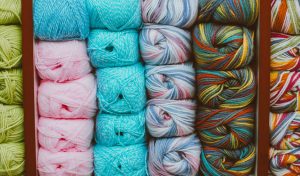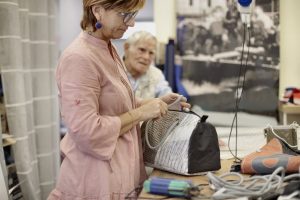The Therapeutic Power of Sewing: A Stitch in Time for Mental Well-being
In a world increasingly characterized by fast-paced living and constant digital stimulation, finding solace and balance for our mental well-being is more crucial than ever. While traditional therapies are valuable, exploring alternative approaches that tap into the innate human need for creativity and expression can offer a powerful path to healing. One such approach is the art of sewing, a seemingly simple craft that holds a surprising depth of therapeutic potential.
With its rhythmic repetition of stitches and the tangible creation of something new, Sewing offers a unique combination of cognitive engagement, mindfulness, and creative expression that can profoundly impact our mental and emotional state. This intricate interplay of mind and hand allows individuals to escape the constant barrage of external stimuli and enter a state of focused attention. The repetitive sewing can induce a meditative state, calming the mind and easing anxiety. This calming effect is further enhanced by the tactile nature of the craft, providing a grounding experience that can help individuals feel more connected to their bodies and the present moment.
The creative aspect of sewing also plays a crucial role in its therapeutic benefits. Individuals can express their unique personalities and tap into their creative potential by choosing fabrics, colors, and patterns. This self-expression can be incredibly empowering, allowing individuals to feel a sense of agency and control over their lives. Moreover, creating something tangible from scratch fosters a sense of accomplishment and pride, boosting self-esteem and confidence. Studies have shown that engaging in creative activities, such as sewing, can increase dopamine levels, a neurotransmitter associated with pleasure and reward, contributing to feelings of well-being and happiness.
This article explores the growing body of research demonstrating the therapeutic benefits of sewing, examining how this age-old craft can help individuals cope with depression, reduce stress, and enhance overall well-being. We will delve into the specific ways sewing can promote mindfulness, creativity, and a sense of purpose, highlighting the potential of this craft as a valuable tool for mental health and resilience. From providing a calming focus to fostering a sense of accomplishment, sewing can become a meditative practice, allowing individuals to escape the relentless demands of modern life and reconnect with their inner selves. By exploring the therapeutic power of sewing, we can unlock a valuable tool for promoting mental health and resilience in an increasingly complex world.
Sewing as a Mindfulness Practice
At its core, sewing encourages a state of mindfulness, a crucial element in managing stress and anxiety. The repetitive motions of threading a needle, guiding fabric through the machine, and carefully forming stitches create a rhythmic flow that anchors us to the present moment. This focused attention on the task at hand lets us momentarily detach from intrusive thoughts and worries, creating a space for mental clarity and relaxation. Imagine the feeling of your fingers gently guiding the fabric, the sewing machine’s soft whirring, and the foot pedal’s satisfying click. These sensory experiences ground us in the present, offering a much-needed respite from the constant chatter of our minds.
Studies have shown that engaging in repetitive activities like knitting or crocheting, which share similarities with sewing, can effectively lower cortisol levels, the stress hormone. This reduction in cortisol can lead to a calmer state of mind, improved sleep quality, and a greater sense of well-being. The act of sewing, therefore, can be seen as a form of meditative practice, offering a much-needed respite from the constant demands of modern life. For example, a study published in the journal ‘Complementary Therapies in Medicine’ found that participants who engaged in knitting for 30 minutes a day experienced a significant decrease in anxiety and stress levels compared to a control group. This suggests that the repetitive and focused nature of sewing can have tangible benefits for mental health.
Beyond reducing stress, sewing can foster a sense of accomplishment and pride. Transforming fabric into a finished product, whether a simple scarf or a complex garment, provides a tangible manifestation of our creative abilities. This sense of accomplishment can boost self-esteem and contribute to a more positive self-image, counteracting feelings of inadequacy or helplessness that often accompany depression. Seeing a project come to life, stitch by stitch, can be incredibly empowering, reminding us of our capabilities and resilience. This feeling of accomplishment can be precious for individuals struggling with low self-worth or lack of control.
The Creative Outlet of Sewing
Sewing, at its essence, is a creative act. It allows us to express ourselves through fabric and thread, translating our thoughts, feelings, and ideas into tangible creations. For individuals struggling with depression, this creative outlet can be particularly therapeutic. When words fail to capture the complexity of emotions, sewing provides a visual language, allowing individuals to express themselves without needing to articulate their inner turmoil. The colors, textures, and patterns we choose can reflect our moods, hopes, and dreams, allowing us to externalize and process our emotions.
Studies suggest that engaging in creative activities like sewing can stimulate the release of dopamine, a neurotransmitter associated with pleasure and reward. This release of dopamine can elevate mood and provide a sense of joy and satisfaction, counteracting the feelings of apathy and hopelessness often associated with depression. Bringing a creative vision to life can be deeply fulfilling, giving individuals a sense of purpose and control over their lives. The act of creation can be a powerful antidote to feelings of helplessness and isolation, reminding us of our ability to make a difference in the world, even in small ways. For example, a study published in the ‘Journal of Positive Psychology’ found that participants who engaged in creative activities like painting, writing, or music-making reported a significant increase in happiness, well-being, and self-esteem. This suggests that engaging in creative pursuits can positively impact our mental and emotional well-being.
Moreover, sewing can foster a sense of community and connection. Joining sewing groups, participating in workshops, or simply sharing our creations with others can create a supportive network of like-minded individuals. This sense of belonging can be precious for those struggling with mental health challenges, reducing feelings of isolation and fostering a sense of purpose and connection. Sharing our creative endeavors with others can also provide validation and encouragement, reminding us that we are not alone in our struggles. The shared passion for sewing can create a sense of camaraderie and understanding, fostering a sense of belonging and support.
Sewing as a Tool for Self-Care
In a world that often prioritizes productivity and external validation, sewing offers a space for self-care and self-compassion. It encourages us to slow down, listen to our inner needs, and prioritize our well-being. Creating something beautiful for ourselves or others can be a deeply nurturing experience, reminding us of our inherent worth and capacity for self-love. Sewing allows us to focus on the present moment, appreciate the beauty of the process, and create something that brings us joy. This act of self-care can be a powerful way to combat the negative self-talk and self-criticism that often accompany mental health challenges.
Sewing can also provide a sense of structure and routine, which can be particularly beneficial for those struggling with depression. The predictability of the sewing process, with its distinct steps and clear objectives, can provide a sense of control and stability in a chaotic world. This sense of order and predictability can be immensely comforting, offering a grounding force amidst the emotional turmoil that accompanies mental health challenges. A regular sewing routine can provide a sense of purpose and accomplishment, even when we feel overwhelmed or unmotivated. This sense of structure can help us to manage our time effectively, to prioritize our well-being, and to create a sense of order in our lives.
Setting aside time for sewing creates a space for self-reflection and introspection. Focusing on the task at hand allows us to distance ourselves from our worries and anxieties, giving us the space to observe our thoughts and emotions with greater clarity. This mindful awareness can be a powerful tool for managing our mental health, allowing us to identify patterns, challenge negative thoughts, and cultivate a more balanced and resilient perspective. Sewing can be meditative, allowing us to connect with our inner selves and develop a sense of peace and well-being. The quiet focus on the task at hand can provide a much-needed break from the constant stimulation of modern life, allowing us to recharge and reconnect with ourselves.
In conclusion, sewing emerges as a potent and multifaceted therapeutic practice, offering a unique blend of mindfulness, creativity, and self-care that can significantly enhance mental well-being. Sewing provides a much-needed respite from the relentless pressures of modern life, allowing individuals to step away from the constant bombardment of stimuli and immerse themselves in a focused, meditative activity. This deliberate engagement with creating something tangible fosters a sense of calm and control, effectively mitigating anxiety and promoting relaxation.
Beyond its stress-reducing qualities, sewing empowers individuals to tap into their creative potential, fostering a sense of accomplishment and boosting self-esteem. The ability to transform fabric into a garment or an object of beauty provides a tangible manifestation of one’s skills and imagination, instilling a sense of pride and confidence. Studies have shown that engaging in creative activities, such as sewing, can increase dopamine levels, a neurotransmitter associated with pleasure and reward, contributing to a more optimistic outlook.
Furthermore, the act of sewing can be deeply therapeutic for individuals struggling with depression. The repetitive nature of the stitches, the tactile experience of working with fabric, and the gradual emergence of a completed project can provide a sense of purpose and accomplishment that can be particularly valuable for those experiencing hopelessness and apathy. A 2018 study published in the Journal of Occupational Therapy found that participants who engaged in regular sewing sessions reported significant improvements in their mood, self-efficacy, and overall well-being.
The therapeutic benefits of sewing extend beyond individual well-being, fostering a sense of community and connection. Sewing circles and workshops provide a welcoming space for individuals to share their skills, learn from others, and interact socially. This shared experience of creativity and craftsmanship can build a sense of belonging and support, offering a valuable counterpoint to the isolation and loneliness that can often accompany mental health challenges. In essence, sewing provides a powerful and accessible tool for promoting mental well-being, offering a stitch in time for a healthier and more fulfilling life.

Photo by Pavel Danilyuk on Pexels







Your point of view caught my eye and was very interesting. Thanks. I have a question for you.